Vojdani Medical Diagrams

Prepared by Dr. Aristo Vojdani, PH.D., M.T.
Immunosciences Laboratories, Los Angeles, CA.
TheGlutenSyndrome.net gratefully acknowledges this valuable contribution to the gluten syndrome community.
These copyrighted diagrams may be downloaded for doctor visits and non profit educational use. Tests may be ordered at Neuroimmunology Labs.
Click for an audio explanation of these diagrams
"Dietary Proteins and Peptides
from Gastrointestinal to Neuroimmune Disorders"
presented by Dr. Vojdani to the Pan American Allergy Society,
March 2007, Grapevine, Texas, 46 minutes
~
The Role of Mucosal Immunity in Complex Diseases
(also Consequences of Food Processing of Dietary Proteins)
Presentation slides for Role of Mucosal Immunity lecture
Presented by Dr. Vojdani to the Pan American Allergy Society
March 2008, Woodlands, Texas, 60 minutes
These medical diagrams are presented below twice. The first set, bordered in green, is presented without detailed explanation so the reader can easily compare between them.
Beyond the green bordered diagrams is a second presentation of these diagrams with simple and detailed text explanations for further study.
A chart of test panels is included at the bottom of the page which highlights tests recommended by Dr. Vojdani based on his and other researchers' work.
References are included with full text downloads. This website/owner has no financial interest in any products or services mentioned on the site.
Normal Healthy Gut Response
to Minor Stress, Minor Chemical Injury (toxins) and Minor Infections
Early childhood exposure to bacteria aids normal suppression of immune response
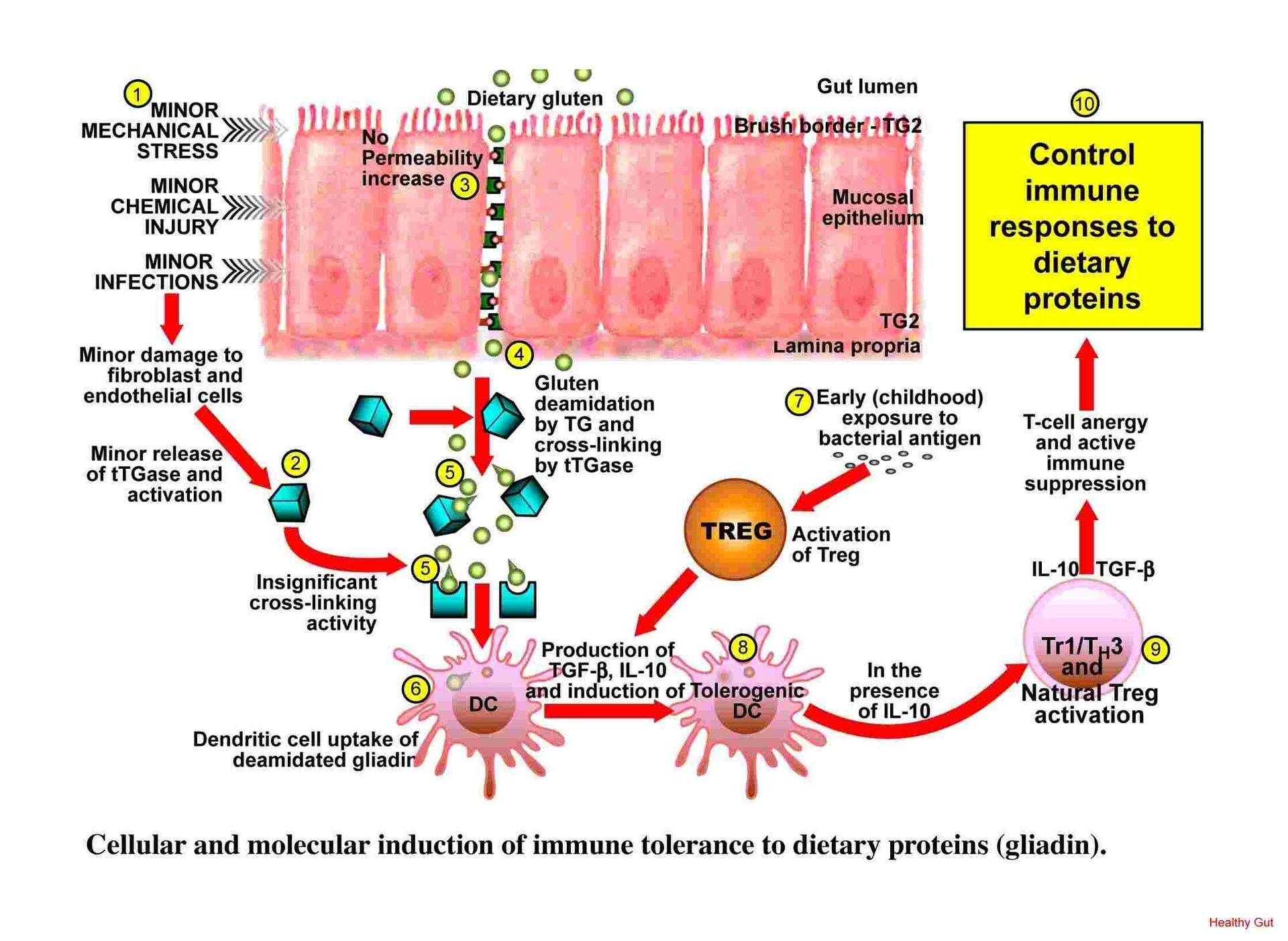
Celiac Disease Gene Mediated Response to Stress, Chemical Injury (toxins) and Infections
Leads to widespread autoimmunity vulnerability.
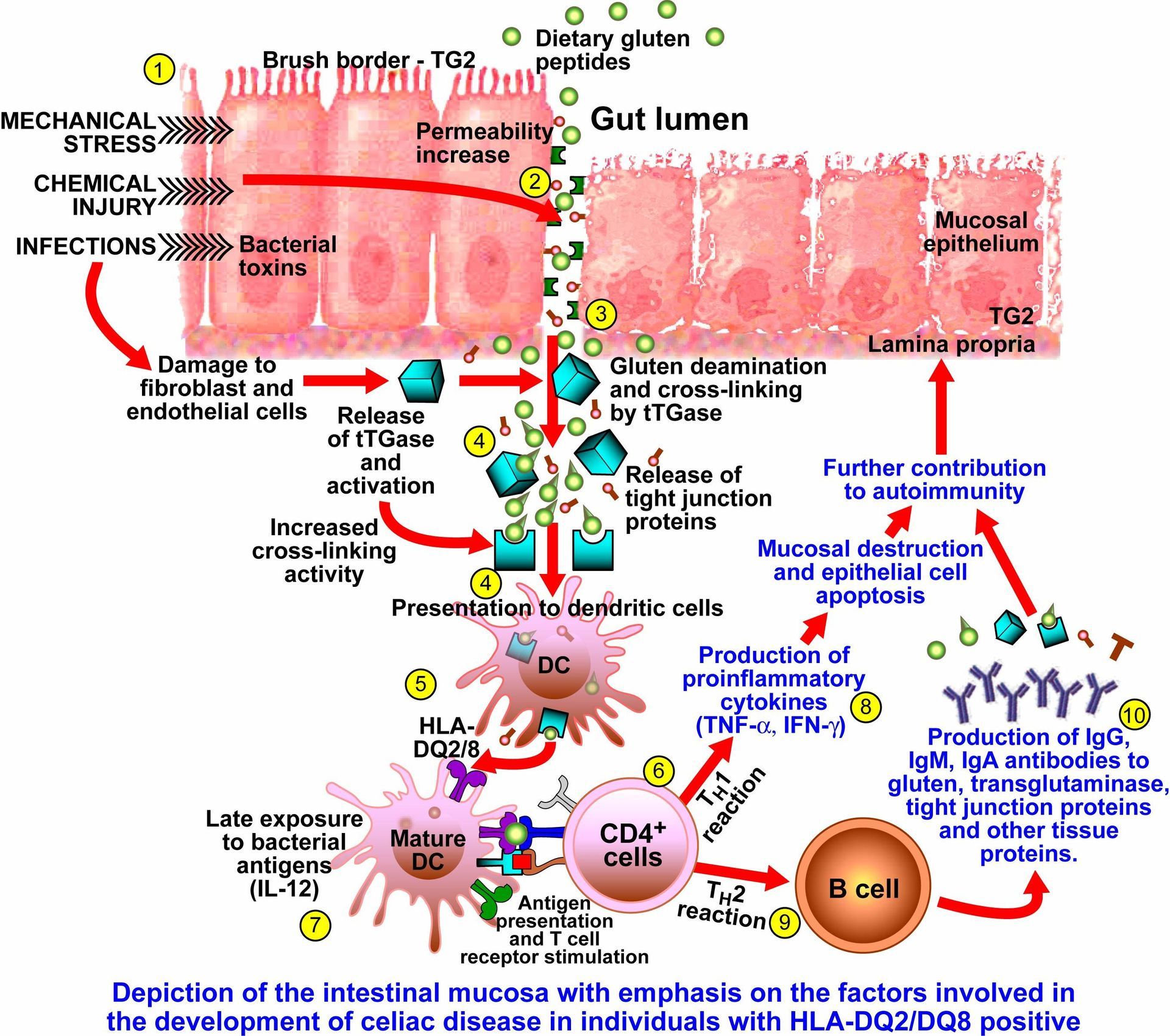
Gluten Intolerance Reaction to Stress, Chemical Injury (toxins), and Infections without Gene Involvement.
Leads to widespread autoimmunity and other vulnerabilities.
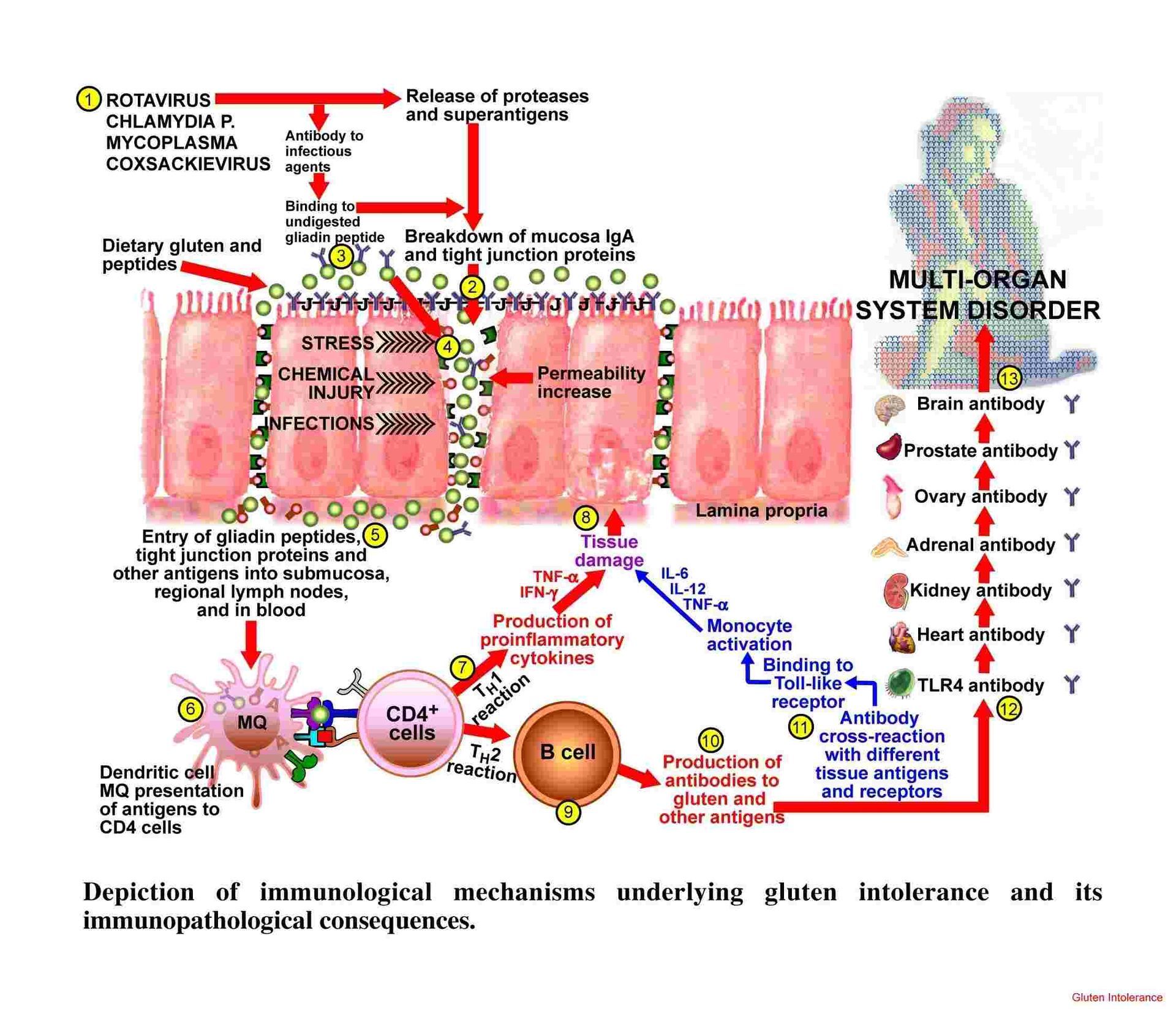
Gluten Sensitivity (IgE Allergy reaction) to toxins or strenuous exercise
This is an ALLERGIC reaction similar to a bee sting or peanut allergy.
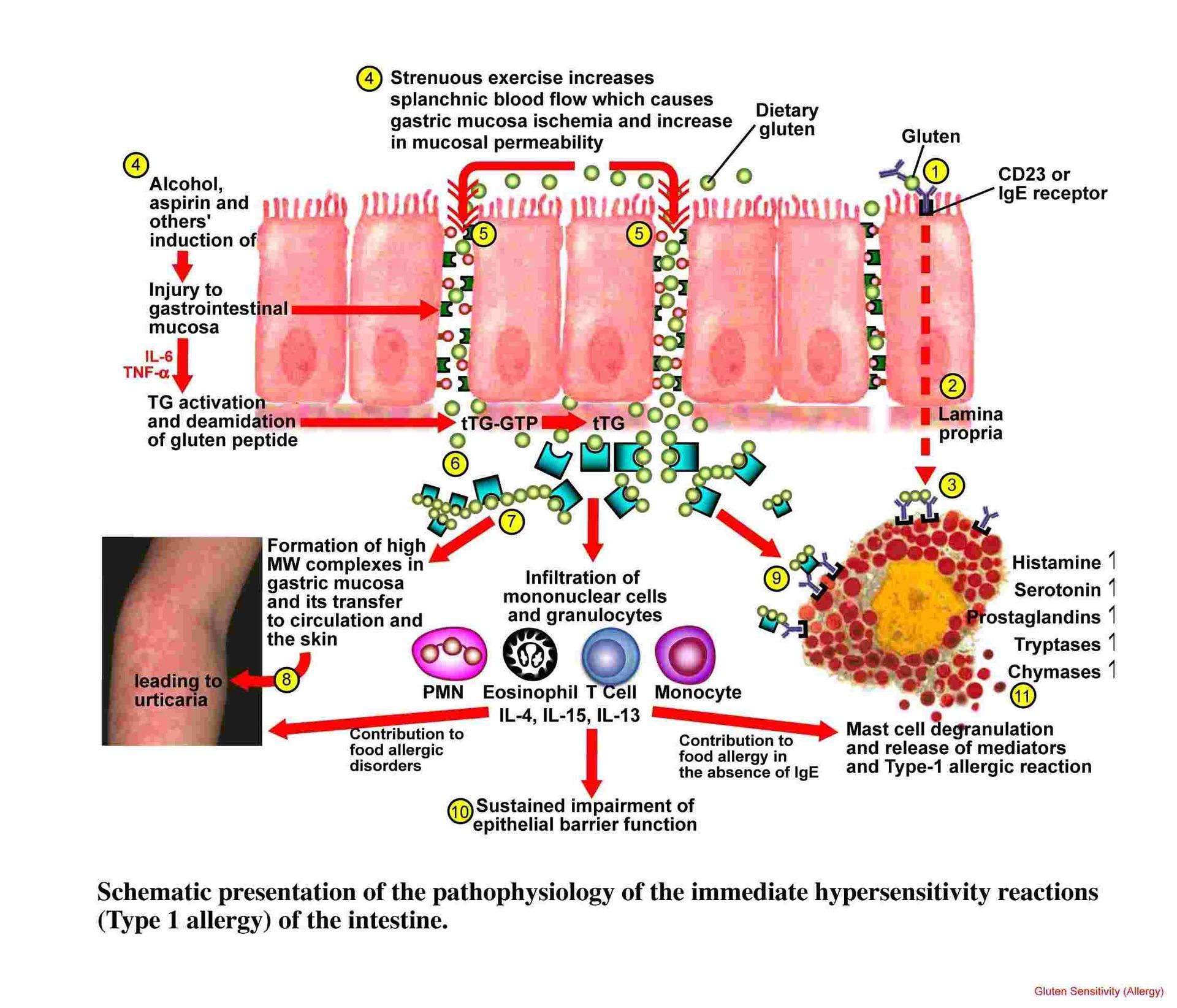
Healthy Gut response to gluten exposure (and similar substances) in the presence of
minor stress, minor chemical injury (toxins), and minor infections
~
Notes to non medical viewers. The important points to understand in this diagram are as follows.
A. Stress, chemical injury (toxins) and infection are MINOR. (1)
B. Very few gluten molecules pass the healthy gut wall even in the presence of minor stress, toxins, and infection. (3)
C. Early childhood exposure to bacteria produces a protective mechanism (7) that suppresses (hinders) immune
response (allergies and intolerances). (10). This healthy process takes place with most foods that enter the normal gut.
Simply put, children NEED some normal common sense exposure to dirt and bacteria to build their immunities.
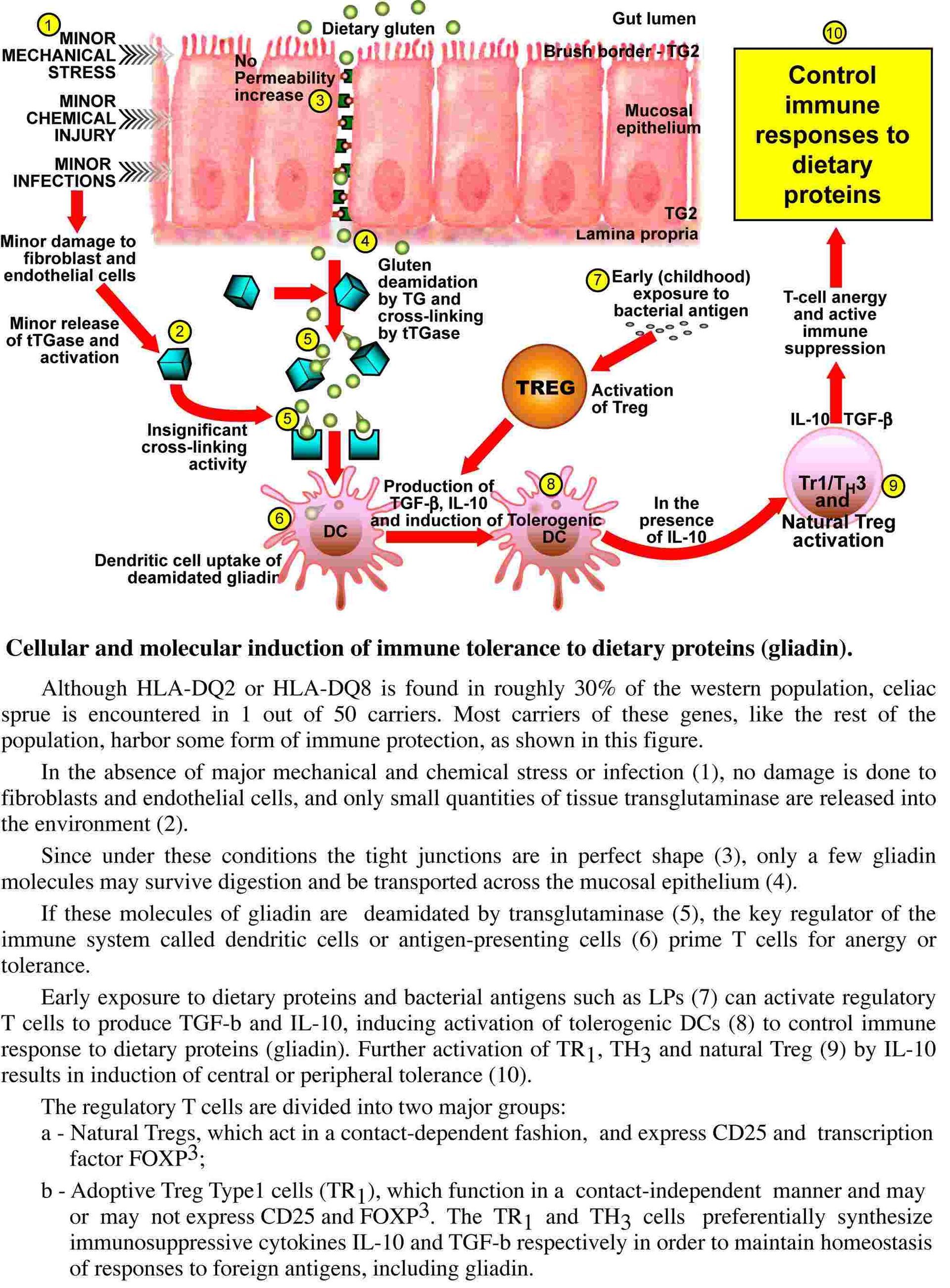
Celiac Disease (villi damage)
Gene Mediated Response to Stress, Chemical Injury (toxins) and Infections
Leads to widespread autoimmune, malabsorptive, inflammatory and other vulnerabilities.
~
Notes to non medical viewers. The important points to understand in this diagram are as follows.
A. Stress, chemical injury (toxins) and/or infections are significant. (1)
B. Gut damage is significant and more gluten molecules pass the gut wall. (2) A common term for this condition is "leaky gut". This activates antibodies to form in the blood stream against one or more gluten/gliadin/wheat related molecules.
C. Specific genes (5) contribute to this particular reaction pathway, making it easier for antibodies to be formed. The antibodies bind to many substances including body tissues that "look similar" to gluten (10). The antibodies then attract "killer cells" (8) to the substances with which they bind including body tissues. This damages the tissues, and is called an autoimmune reaction. (5)
D. Formation of antibodies to various products of this process cross react with many tissues to produce autoimmunity. (10) Note the "T" in red denotes "tissues". In simple terms these "T" tissues are body tissues such as organ, brain, nerve, and many more.
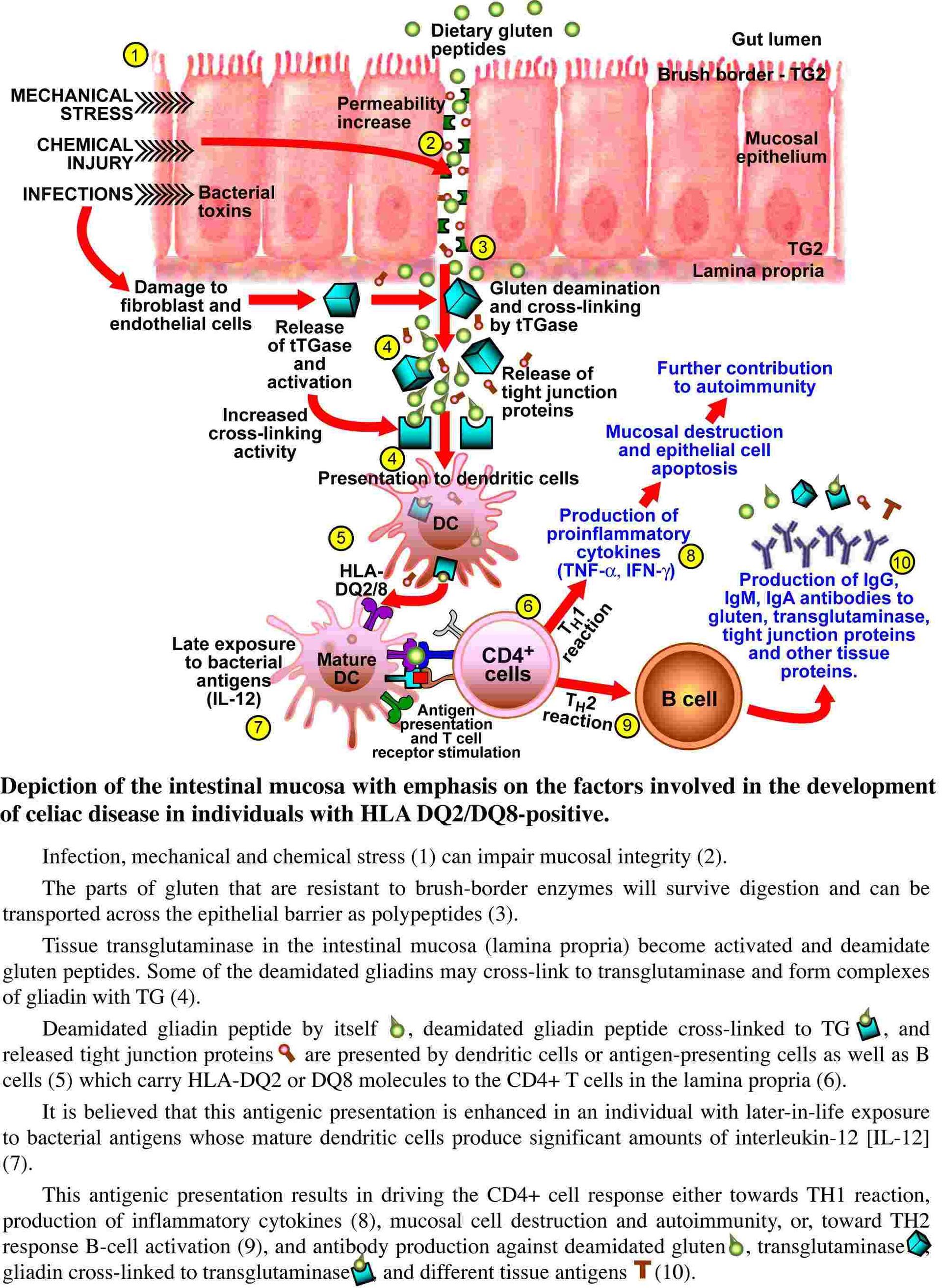
Gluten Intolerance
(also milk and multiple food intolerances)
Gluten Intolerance Reaction to Stress, Chemical Injury (toxins), and Infections
without Gene Involvement .
Leads to widespread autoimmune vulnerability.
~
Notes to non medical viewers. The important points in this diagram to understand are as follows.
A. The infections listed (1) are simply the agents observed in research studies. (1) They are not necessarily the only infections that may contribute to this type of reaction.
B. Stress, chemical injury (toxins) and/or infections contribute to significantly to gut wall damage.
C. The gut wall is very badly damaged (8) and "leaky" (4). This allows many large food peptides (pieces) to cross the gut wall before sufficient digestion can appropriately break them into very tiny pieces. These pieces enter the cell, (6), are rejected and pushed back to the cell surface to be recognized and destroyed by killer cells (7). This is only one of several destructive reactions.
D. This reaction can happen to anyone! This gluten/other food intolerance pathway does NOT require a predisposing gene.
E. This pathway produces antibodies (symbolized by Y) which then "stick to" or "tag" many body or organ tissues like dunce caps. This marks that tissue for autoimmune destruction by various killer cells. Please carefully examine (13). Note that the human figure is covered with "Y" (antibody) symbols. The list of known affected body tissues and organs is not complete in this diagram.
F. Since this pathway involves cross reactions with many body/organ tissues and eventually with multiple foods, testing is recommended for a number of gluten related antibodies, AND milk and other problematic food proteins PLUS several susceptible organs and other related markers. (See Celiac Neuroautoimmune Panel, Immunosciences Laboratories, below). This blood panel contains many tests for gluten reactivity, other foods that cross react with gluten, and for multiple organ/tissue damage.
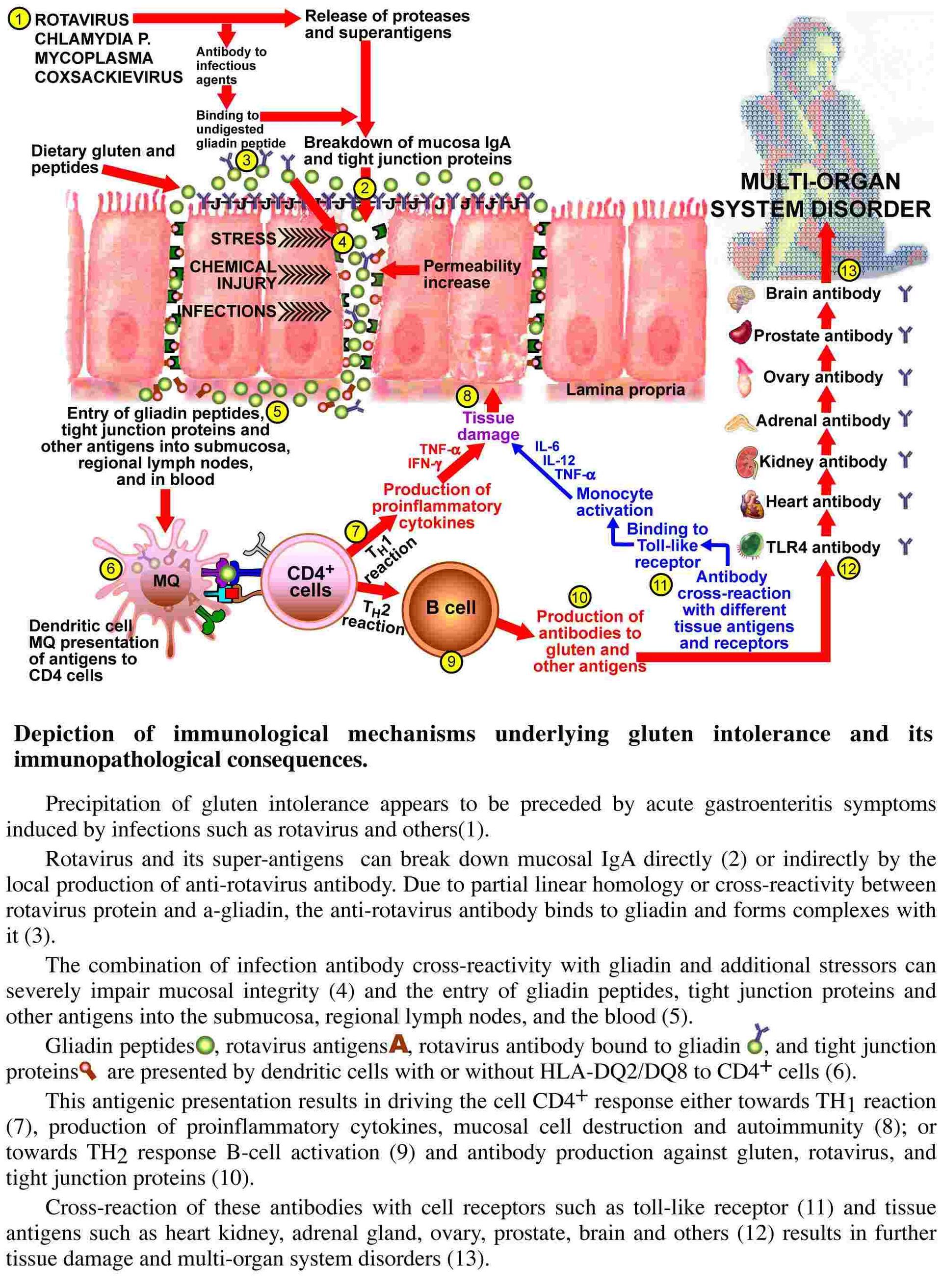
Gluten Sensitivity (Allergy)
Gluten Sensitivity (IgE Allergy reaction) to toxins or strenuous exercise
~
Notes to non medical viewers. The important points in this diagram to understand are as follows.
A. This reaction is commonly recognized as an "allergic" reaction.
B. This reaction pathway can be triggered by alcohol, chemical toxins found in food along with gluten, several classes of
medications including aspirin, and also strenuous exercise.
C. The gut is quite "leaky".
D. Continued exposure to gluten under the above conditions causes "bubbles" or "balloons" full of chemicals to burst and flood
the body with histamines and other substances.This may trigger hives, respiratory distress, and other symptoms which need
immediate treatment. Patients may carry Epinephrin/Epi-pens for such emergencies. This reaction is similar to a bee sting
or peanut allergy reaction.
E. These reactions are usually tested with IgE "scratch tests" called RAST tests.
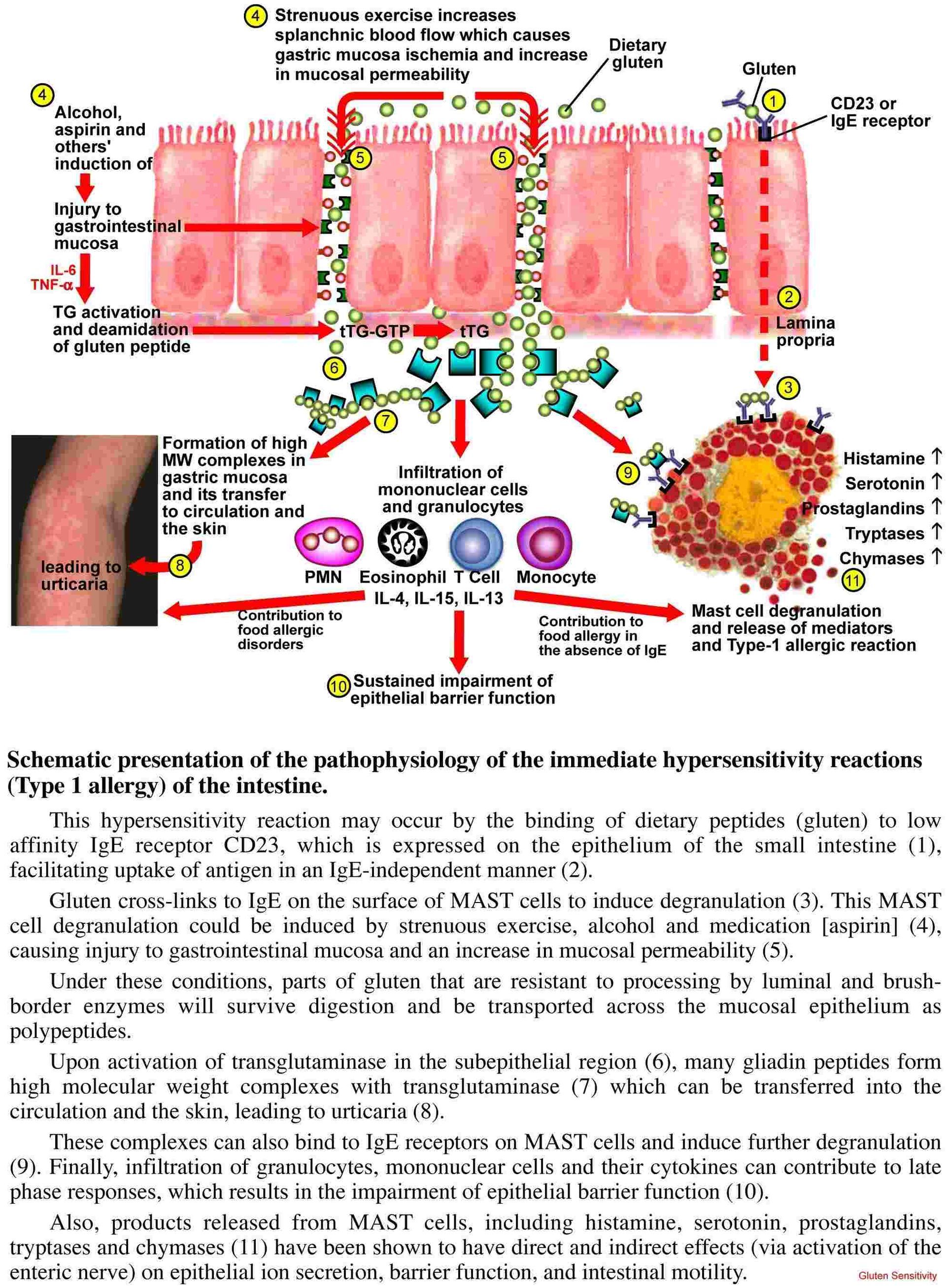
Immunosciences Laboratories is in the process of reorganization
New facilities and panels are in progress. Watch for further developments this winter.
Test information and research is left here in the interim for educational and planning purposes.
~~
Dr. Aristo Vojdani Ph.D., M.T., of Immunosciences Laboratories
Immunosciences Laboratories is a research lab
Video clips of Dr. Vojdani
Part 1 Quicktime Dialup, DSL Windows Media Dialup, DSL
Part 2 Quicktime Dialup, DSL Windows Media, Dialup, DSL
Click for an audio explanation of the Medical Diagrams on the Medical Diagrams page of this website
"Dietary Proteins and Peptides
from Gastrointestinal to Neuroimmune Disorders"
presented by Dr. Vojdani to the Pan American Allergy Society,
March 2007, Grapevine, Texas, 46 minutes
~~~~
NEW AUDIO (June, 2008)
The Role of Mucosal Immunity in Complex Diseases
(also Consequences of Food Processing of Dietary Proteins)
Presentation slides for Role of Mucosal Immunity lecture
Presented by Dr. Vojdani to the Pan American Allergy Society
March 2008, Woodlands, Texas, 60 minutes
Questions? email info@neuroimmunologylabs.com attn: Jama
Phone: (310)-657-2684 Fax (310) 657-1053
Research articles available at www.immunoscienceslab.com
Questions? email info@neuroimmunologylabs.com attn: Jama
** Cross Reactions with foods , toxins, infections, and other tissues?
- Immune response to dietary proteins, gliadin and cerebellar peptides in children with autism. Nutr Neurosci. 2004 Jun;7(3):151-61.Vojdani A, O'Bryan T, Green JA, Mccandless J, Woeller KN, Vojdani E, Nourian AA, Cooper EL. Section of Neuroimmunology, Immunosciences Lab., Inc., 8693 Wilshire Blvd., Ste. 200, Beverly Hills, California 90211, USA. drari@msn.com Full text here
- Infections, toxic chemicals and dietary peptides binding to lymphocyte receptors and tissue enzymes are major instigators of autoimmunity in autism. Int J Immunopathol Pharmacol. 2003 Sep-Dec;16(3):189-99 Vojdani A, Pangborn JB, Vojdani E, Cooper EL Lab. Comparative Immunology, Dept. Neurobiology, UCLA Medical Center, Los Angeles, CA, USA. DrAri@msn.com Full Text here
- In Celiac Disease, A Subset of Autoantibodies against Transglutaminase Binds Toll-Like Receptor 4 and Induces Activation of Monocytes Published Sept 19, 2006 Giovanna Zonomi1, Niccardo Navone2, Claudio Lunardi2, Giuseppe Tidente1, Carerina Bason2, Simona Sivori3, Buggero Beri2 Marzia Dolcino4, Enrico Valletta5, Roberto Corrocher2, Antonio Puccetti3,4 Click for abstract and full text
1. Section of Immunology, Department of Pathology, Universtiy of Verona, Verona, Italy,
2. Section of Internal Medicine, Department of Clinical and Experimental Medicine, University of Verona, Verona, Italy
3. Section of Histology, Departmant of Experimental Medicine, University of Genova, Genova, Italy
4. Immunology Unit, Institute G. Gaslini, Genova, Italy,
5. Department of Pediatrics, University Hospital of Verona, Verona, Italy
- Immunological cross reactivity between Candida albicans and human tissue. J Clin Lab Immunol. 1996;48(1):1-15. Vojdani A, Rahimian P, Kalhor H, Mordechai E., Immunsciences Lab Inc., Beverley Hills, CA 90211, USA Full text here
- The Immunology of Immediate and Delayed Hypersensitivity to Gluten - European Journal of Inflammation Vol 6 No. 1 1-10 (2008) Editorial - A. Vojdani Beverly Hills, CA
- (now Los Angeles, CA) T. O'Bryan, Warrenville, IL,( now Chicago, Il), G. H. Kellermann Neuroscience, WI, USA Full text here Note: This file contains 2 articles from the journjournal. Scroll to the top to find the Vojdani article
- The Immunology of Gluten Sensitivity Beyond the Intestinal Tract - European Journal of Inflammation Vol 6 No 2, 0-0 (2008) Aristo Vojdani, PH.D, M.T., Thomas O'Bryan, D.C., C.C.NCCN, DACBN Full text here
- The Gluten Response in Children with Celiac Disease is Directed toward Multiple Gliadin and Glutenin Peptides - Willemijen Vader, Yvonne Kooy, Peter Van Veelen,
- Arnoud de Ru, Diana Harris, Willemien Benckhuijsen, Salvador Pena, Luisa Mearin, Jan Wouter Drijfhout, and Frits Koning Departments of Immunohematology and
- Blood Transfusion and Paediatrics, Leiden University Medical Centre, Leiden, The Netherlands; and the Free University, Amsterdam, The Netherlands
- Gastroenterology 2002; 122:1729-1737 Full text here
- NEW powerpoint by Dr. Vojdani presented at Autism One conference, May, 2010 - I Don't Want to Be 17 This presentation discusses the role of mucosal immune abnormalities in Neurodegeneration and focuses on IL-17.
Dr Vojdani is a gluten syndrome focused researcher. His test panels are oriented to diagnosing a wider scope of the gluten syndrome.
NOTE: Cyrex Labs is now open with detailed gluten related antibody panels in saliva and blood. Dr. Vojdani is Cyrex Labs' chief scientific advisor. More info coming asap.
*This website has no financial interest in products or services mentioned on this site.
There are two major perspectives on the gluten syndrome vs. celiac disease that involve how to test and interpret tests.
Gluten Syndrome focused researchers believe -
- antibodies are conclusive proof of immune reaction to gluten and indicate need for the gluten free diet. They do NOT recommend villi biopsy unless there are other reasons to examine the gut. They use other comprehensive blood test panels to find multiple tissue and function damage instead of focusing on only one tissue, (villi).
- there are many gluten related antibodies, and they may show up in any of several areas of the immune system, IgA, IgG, or IgM, or in any of several mediums, such as blood, saliva or stool. They test as many antibodies as necessary to find the particular antibodies a patient may produce, with much higher rates of positivity than short panels yield. However, in the end they consider even the most complete negative test panel necessarily inconclusive since there are known antibodies for which there are no tests at this time (this is uncommon).
- gluten syndrome patients may have autoimmune damage in any of many possible body areas instead of or as well as villi damage. Therefore they do NOT use the tTG test to screen for reactivity to gluten since tTG is specific to one area of damage only, total intestinal villi atrophy.
- Dr Vojdani, Immunosciences Laboratories, believes elevated tTG is sometimes but not always present in a gluten related autoimmune reaction. Therefore he believes it should be included in test panels but not used alose as a screener.
Celiac (villi damage focused) specialists believe -
- ONLY intestinal villi or skin damage proved by biopsy are "gold standard" indicators of autoimmune gluten damage and treatment with gluten free diet. If gluten related antibodies are present without villi or skin damage the antibodies are disregarded as irrelevant or false positive.
- tTg - IgA alone is an inexpensive screener to identify patients who should be biopsied for villi damage since it is largely specific to villi damage.
All Rights Reserved | The Gluten Syndrome

